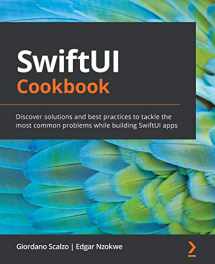
SwiftUI Cookbook: Discover solutions and best practices to tackle the most common problems while building SwiftUI apps
Book details
Summary
Description
Unleash the power of declarative programming in SwiftUI with practical recipes for building cross-platform Apple applications for iOS 14, macOS, and watchOS using Swift 5.3, Xcode 12, and SwiftUI 2.0
Key Features- Apply the declarative programming paradigm for building cross-platform UIs for Apple devices
- Learn to integrate UIKit, Core Data, Sign in with Apple, and Firebase with SwiftUI
- Adopt the new SwiftUI 2.0 features to build visually appealing UIs at speed
SwiftUI is an innovative and simple way to build beautiful user interfaces (UIs) for all Apple platforms, right from iOS and macOS through to watchOS and tvOS, using the Swift programming language. In this recipe-based book, you'll work with SwiftUI and explore a range of essential techniques and concepts that will help you through the development process. The recipes cover the foundations of SwiftUI as well as the new SwiftUI 2.0 features introduced in iOS 14. Other recipes will help you to make some of the new SwiftUI 2.0 components backward-compatible with iOS 13, such as the Map View or the Sign in with Apple View.
The cookbook begins by explaining how to use basic SwiftUI components. Then, you'll learn the core concepts of UI development such as Views, Controls, Lists, and ScrollViews using practical implementation in Swift. By learning drawings, built-in shapes, and adding animations and transitions, you'll discover how to add useful features to the SwiftUI. When you're ready, you'll understand how to integrate SwiftUI with exciting new components in the Apple development ecosystem, such as Combine for managing events and Core Data for managing app data. Finally, you'll write iOS, macOS, and watchOS apps while sharing the same SwiftUI codebase.
By the end of this SwiftUI book, you'll have discovered a range of simple, direct solutions to common problems found in building SwiftUI apps.
What you will learn- Explore various layout presentations in SwiftUI such as HStack, VStack, LazyHStack, and LazyVGrid
- Create a cross-platform app for iOS, macOS, and watchOS
- Get up to speed with drawings in SwiftUI using built-in shapes, custom paths, and polygons
- Discover modern animation and transition techniques in SwiftUI
- Add user authentication using Firebase and Sign in with Apple
- Handle data requests in your app using Core Data
- Solve the most common SwiftUI problems, such as integrating a MapKit map, unit testing, snapshot testing, and previewing layouts
This book is for mobile developers who want to learn SwiftUI as well as experienced iOS developers transitioning from UIKit to SwiftUI. The book assumes knowledge of the Swift programming language. Knowledge of object-oriented design and data structures is useful but not necessary.


We would LOVE it if you could help us and other readers by reviewing the book
Book review



